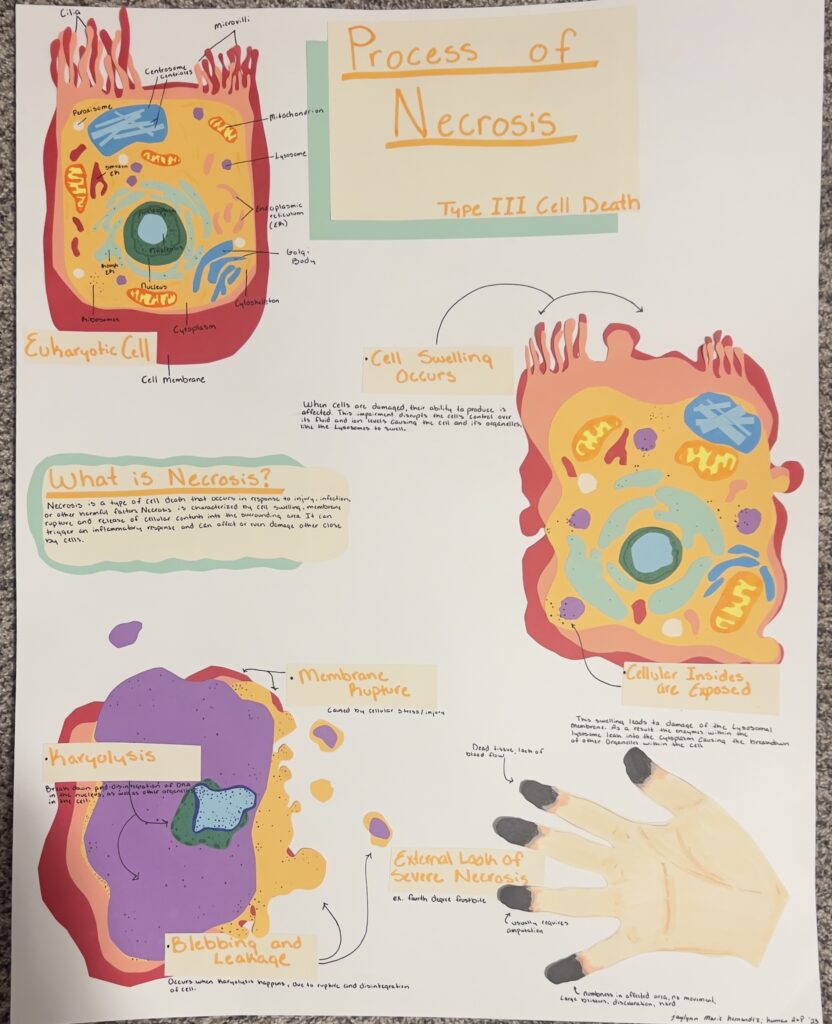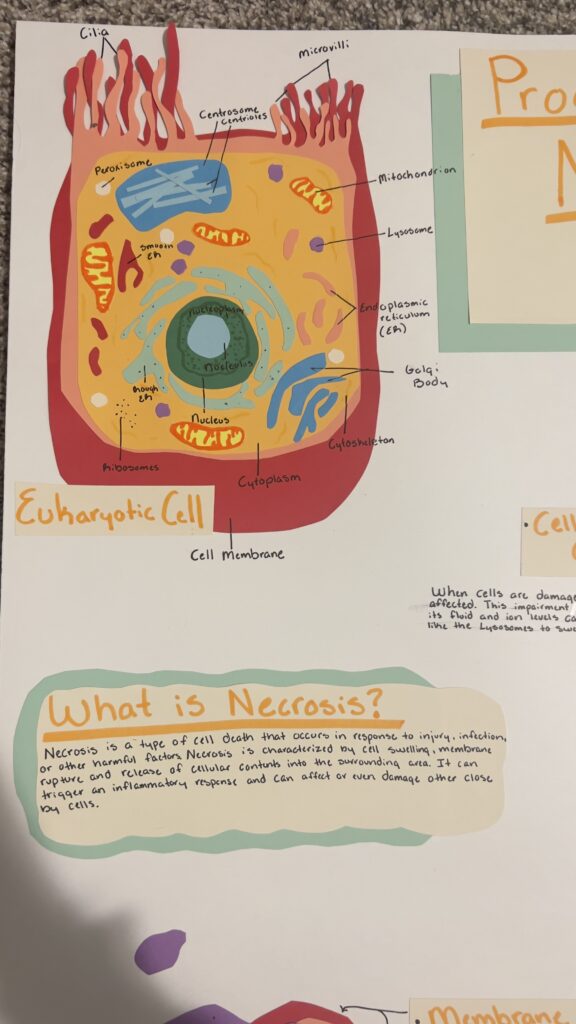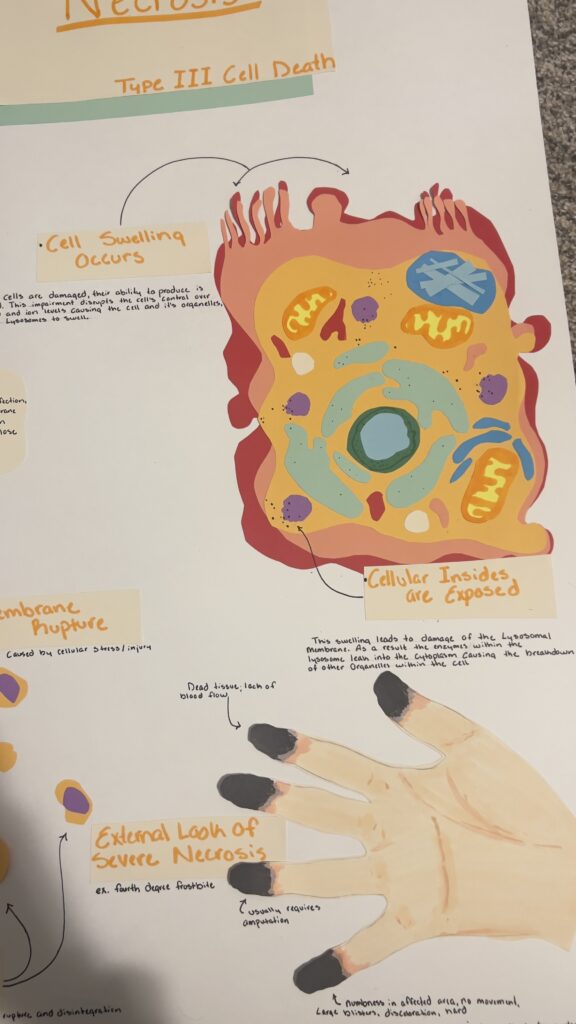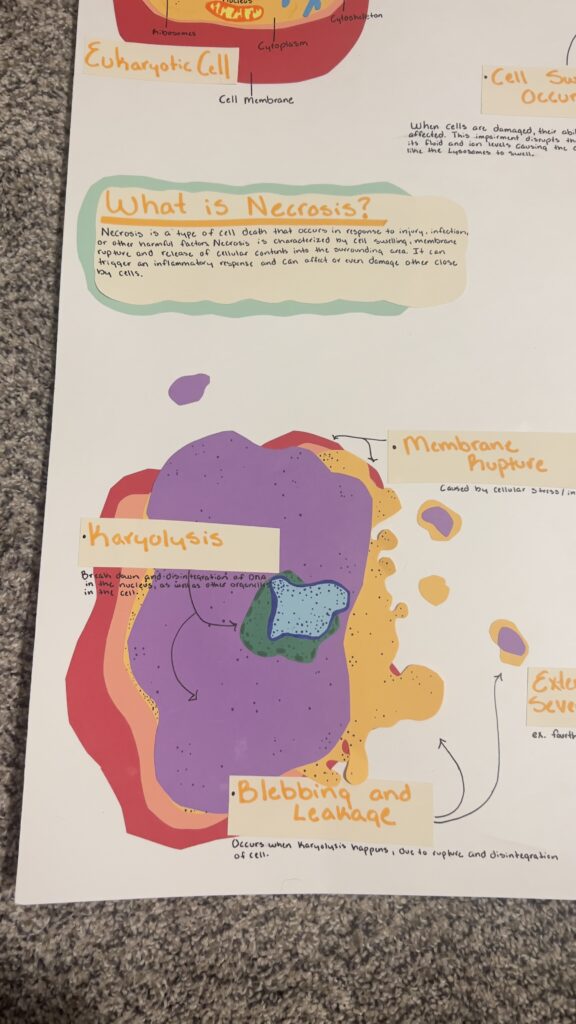



For my STEAM project, I’ll be addressing two objectives “Comparing and contrasting organelles and their functions” and “Describing the functions of the integumentary system.” Within these objectives, I’ll explain the process of necrosis in eukaryotic cells and its association with severe frostbite. Frostbite is a medical condition that occurs when skin freezes due to exposure to frigid temperatures. It happens when the body’s tissues freeze, leading to cellular damage and potentially severe complications. Frostbite can be caused by a combination of sluggish blood flow and small blood clots. The degree of the harm is determined by the length of time you were exposed and the extent of the damage. Blood flow can even cease totally in extremely cold conditions. (Basit, Wallen, Dudley, 2023)
Frostbite is most common in severely cold temperatures and is impacted by variables such as wind chill, dampness, and insufficient clothing. Long term exposure to frigid temperatures raises the risk, and wind can hasten heat loss from the body, making it more vulnerable. Wet or damp clothes, as well as wet skin, raises the risk because moisture carries heat away from the body more readily than dry circumstances. (Long, Edlich, Winters, Britt, 2005) Usually, our skin has a blood flow of about 250 ml/min, but when frostbite happens that flow drops a lot to less than 20-50 ml/min. Also in really cold temperatures, like below 0 degrees celsius, the blood flow stops completely. (Basit, Wallen, Dudley, 2023)
In exposed tissue, ice crystals form outside the cells. Prolonged cold exposure might cause the production of ice crystals inside the cells. This process disrupts the cell membrane, resulting in electrolyte imbalances. The growing osmolarity differential across the cell membrane might cause ruptures and eventually, cell death. If tissue thaws, an inflammatory reaction linked with reperfusion may cause further harm from proinflammatory cytokines. Furthermore, repeated thawing and freezing cycles can cause significant tissue ischemia and subsequent thrombosis, providing much larger hazards. (Department of Health & Human Services, 2001)
Frostbite progresses in phases, beginning with frostnip, which is characterized by numbness and tingling and progressing to more severe stages with skin discoloration, swelling, blistering, and, in extreme cases, full tissue freezing, which can lead to amputation. (Basit, Wallen, Dudley, 2023) The skin may seem blanched or white during a medical examination. Patients may experience heaviness in the exposed extremity as the numbness progresses. Due to low vascular tone and blood pooling in the latter stages of frostbite, exposed parts may take on a black or purple color. Superficial frostbite, which affects the outer skin layers and subcutaneous fat can cause light, white blisters to appear after rewarming. Deep full thickness frostbite can develop hemorrhagic and lead to gangrene following rewarming. The wounded skin may have a well-defined boundary with viable skin surrounding it.( Rivlin, King, Kruse, IIyas, Frostbite in an adolescent football player: A case report 2014)
Swelling may begin within 3-5 hours of the frostbitten region warming up and remain for around a week. Blisters can appear between 4 and 24 hours. After around 10-15 days, you may observe eschar, a hard, dry scab. In 3-8 weeks, the afflicted region may become dry and shriveled, with a distinct line separating it from healthy skin. (Beacon Health System, Frostbite 2022)
The eukaryotic cells that make up tissue are also involved in this and go through a process called necrosis. Necrosis is the cellular process of the damage of the tissue that is caused by frostbite but can be caused by other factors too. Cell necrosis is distinguished by the disintegration of the cell’s outer membrane, which indicates a breakdown in structural integrity. This disruption in the plasma membrane is critical in determining necrotic cell death. It is caused by the breakdown of the protective barrier that divides the cell’s internal environment from its surroundings. (Tonnus, Meyer, Paliege, Belavgeni, Mässenhausen, Bornstein, Hugo, Becker, Linkermann, The pathological features of regulated necrosis 2019) While necrosis is usually caused by extremely severe circumstances, there are certain cases when this form of cell death is a normal physiological occurrence and is regulated as a planned process. Necrosis can be induced by a variety of stressors, including cytokines, ischemia, heat, irradiation, and infections, within the same population of cells. (Proskuryakov, Konoplyannikov, Gabai, Necrosis: A specific form of programmed cell death? 2003)
Eukaryotic cells are complex structures containing various membrane bound organelles, each with specific functions. The nucleus enclosed by a membrane houses genetic material and serves as the control center for cellular activities. The cell membrane, a protective barrier, regulates substance flow. The endoplasmic reticulum is involved in protein and lipid synthesis. The Golgi apparatus processes and packages cellular materials. Mitochondria produce energy (ATP) through cellular respiration. (Libretexts, 4.6: Eukaryotic cells – characteristics of eukaryotic cells 2023) Lysosomes contain enzymes for waste breakdown. The cytoskeleton, a network of protein filaments, provides structural support.(Alu, Han, Ma, Wu, Wei, The role of lysosome in regulated necrosis 2020) During necrosis in eukaryotic cells, uncontrolled cell death leads to significant changes in cellular structures. The cell membrane which normally maintains integrity, is compromised, resulting in its rupture and the release of cellular contents. Mitochondria responsible for energy production, can be damaged affecting the cell’s ability to generate ATP. The endoplasmic reticulum, involved in protein and lipid synthesis may undergo stress or damage. The nucleus, containing genetic material may experience changes such as chromatin condensation or fragmentation. Lysosomes, which contain enzymes for cellular waste breakdown may release their contents contributing to further damage. Overall, necrosis disrupts the normal architecture of the cell, and these changes can have detrimental effects on surrounding tissues. (Khalid & Azimporan, Necrosis – statpearls – NCBI bookshelf – national center for … 2023)
In general, frostbite can lead to necrosis in eukaryotic cells. The freezing temperatures and reduced blood flow during frostbite can cause damage to the cell membrane and disrupt cellular processes. This can result in cell death and tissue damage.
Works Cited
Basit, H., Wallen, T. J., & Dudley, C. (2023, January). Frostbite. https://www.ncbi.nlm.nih.gov/books/NBK536914/
Long , W. B., Edlich, R. F., Winters, K. L., & Britt, L. D. (2005). Cold injuries. https://pubmed.ncbi.nlm.nih.gov/15715518/
Department of Health & Human Services. (2001, July 11). Frostbite. Better Health Channel. https://www.betterhealth.vic.gov.au/health/conditionsandtreatments/frostbite#
Rivlin, M., King, M., Kruse, R., & Ilyas, A. M. (2014, January). Frostbite in an adolescent football player: A case report. Journal of athletic training. https://www.ncbi.nlm.nih.gov/pmc/articles/PMC3917304/
Frostbite. Beacon Health System. (2022). https://www.beaconhealthsystem.org/library/diseases-and-conditions/frostbite?content_id=CON-20372638
Tonnus, W., Meyer, C., Paliege, A., Belavgeni, A., Mässenhausen, A., Bornstein, S., Hugo, C., Becker, J., & Linkermann, A. (2019, February 3). The pathological features of regulated necrosis. https://pathsocjournals.onlinelibrary.wiley.com/doi/full/10.1002/path.5248
Proskuryakov, S. Y. a, Konoplyannikov, A. G., & Gabai, V. L. (2003, January 28). Necrosis: A specific form of programmed cell death?. Experimental Cell Research. https://www.sciencedirect.com/science/article/abs/pii/S0014482702000277
Alu, A., Han, X., Ma, X., Wu, M., Wei, Y., & Wei, X. (2020, July 13). The role of lysosomes in regulated necrosis. https://pubmed.ncbi.nlm.nih.gov/33163342/
Libretexts. (2023, October 31). 4.6: Eukaryotic cells – characteristics of eukaryotic cells. Biology LibreTexts. https://bio.libretexts.org/Bookshelves/Introductory_and_General_Biology/Book%3A_General_Biology_(Boundless)/04%3A_Cell_Structure/4.06%3A_Eukaryotic_Cells_-_Characteristics_of_Eukaryotic_Cells
Khalid, N., & Azimporan, M. (2023, January). Necrosis – statpearls – NCBI bookshelf – national center for … Necrosis. https://www.ncbi.nlm.nih.gov/books/NBK557627/

Kealey Werczynski
BIOL F111x
27 November 23
Abstract Paper: Jaylynn
I read about frostbite and how it is linked to necrosis. Frostbite usually happens in extreme temperatures and will kill tissues and cells. Which then causes you to need your fingertips amputated or whatever may be frostbit. She explains that even wet or windchill can aid in the frostbite process. She goes on to explain how your cells form ice crystals when exposed to cold temperatures for too long. Ice crystals even form inside the cell as well if exposed for too long. She describes this process can cause an imbalance of electrolytes and even cause death of the cells down the line. Prolonged thawing and freezing of the tissues can cause prolonged damage to include thrombosis and tissue ischemia. Frostbite can start with a numbness sensation along with tingling, then start to change colors in the tissues with prolonged exposure to the cold. The skin and tissues will start to die, and you can see your fingertips turn a blackish or purple color. This is due to the lack of blood flow to the fingertips. She explains that eukaryotic cells are also apart of the tissues that undergo the frostbite process as well.
Her art part of the project was done amazingly in my opinion. She completes a paper like example of a cell and labeled everything within the cell. She went into great detail within the cell and the hand for the necrosis part. The hand demonstrates black fingertips, which would be an example of severe frostbite. Within her examples on her art, she provides descriptions of everything that is demonstrated. Which helped me understand what was going on within her project.